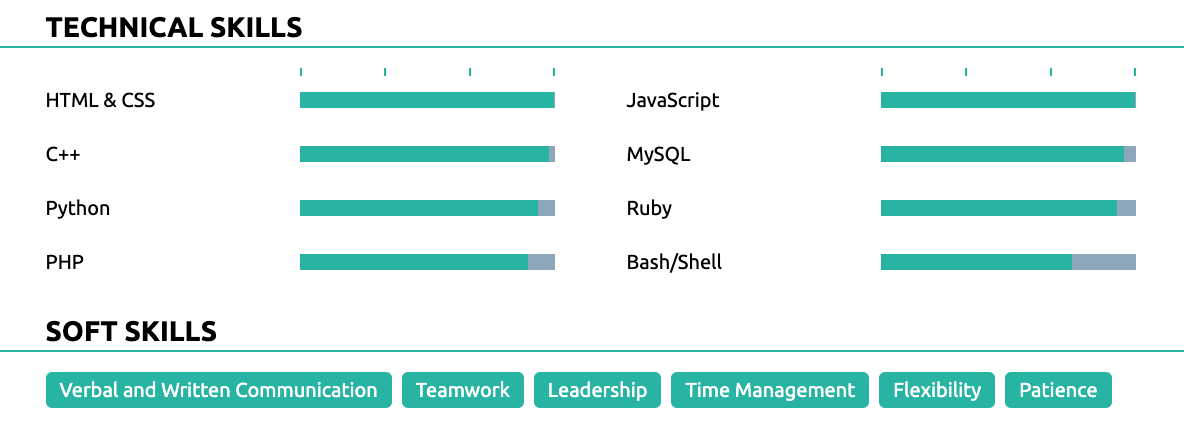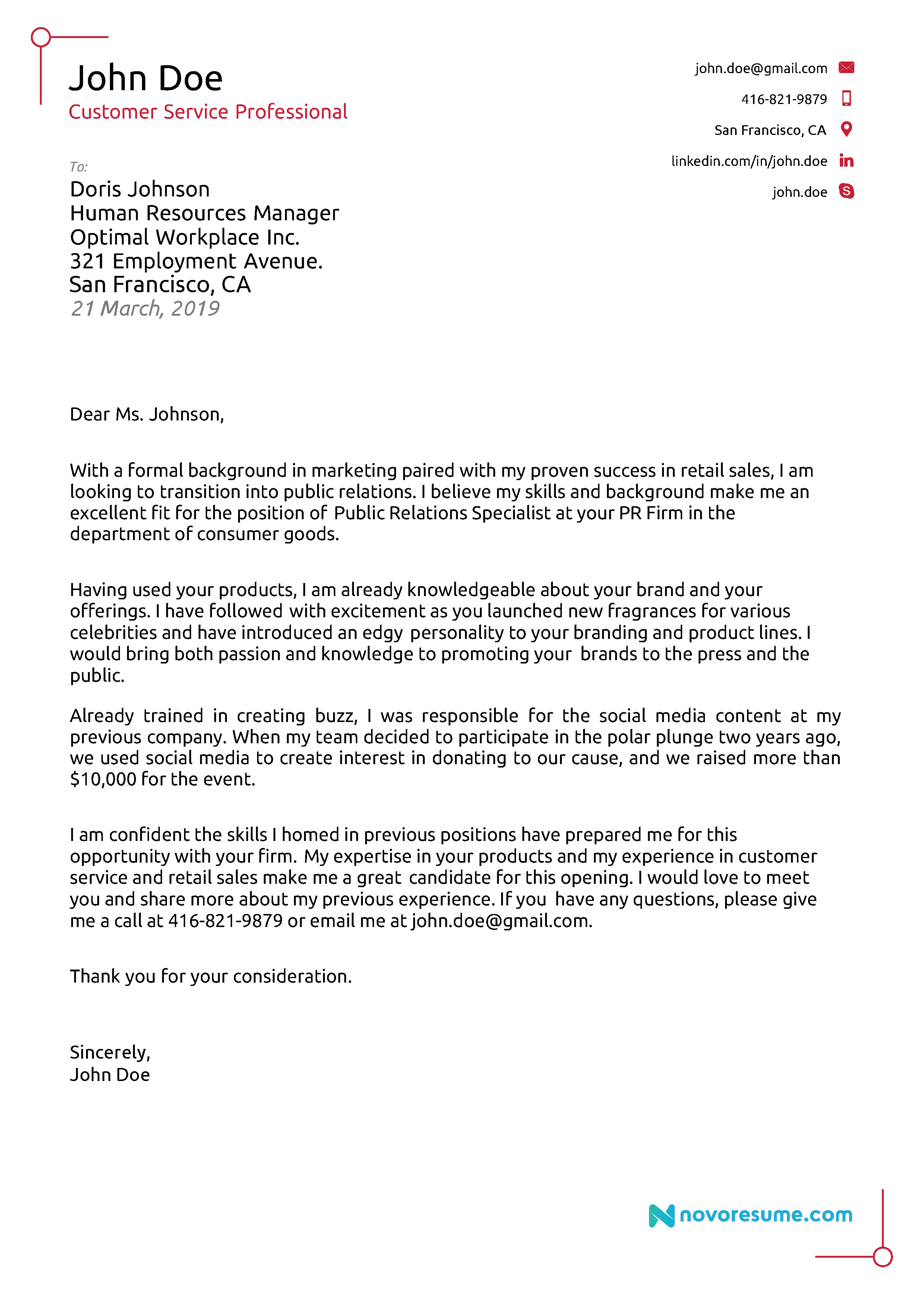Thinking of switching careers?
It might feel a lot like taking a leap of faith.
You’re stepping into the unknown - that alone takes a lot of courage and determination.
You might even feel like a recent graduate all over again.
You have 0 experience, entering an entirely new field, competing with people who’ve been doing it forever!
That sounds pretty scary.
But here’s the thing:
As long as you’re armed with the right resume, the transition can be a piece of cake.
And luckily, we’re here to help and guide you through the process.
So, if you’re thinking of breaking into a new career industry, be sure to read on.
- How to pick the best resume format for a career change
- How to create a skill summary and wow the recruiter
- How to show off transferable work experience
- 3+ other ways to impress the recruiter (even if you have 0 relevant work experience)
Choosing the Best Career Change Resume Format

A big part of creating an effective resume is choosing the right resume format to tell your story with.
You need to structure your resume in a way that best shows your transferable skills and experience.
And when it comes to switching careers, the combination resume format does that best.

Here’s why:
This format places equal emphasis on skills and important work experience.
This way, you can show you have the right industry transferable skills, even if you haven’t had the actual job title.
The format is ideal for people:
- Making a career change with transferable skills or work experience.
- With some employment gaps.
- With a diverse range of skills and experience.
- Applying to both creative and traditional roles.
And here’s what you include within this format:
- Contact information
- Resume objective or summary
- Skills summary
- Work experience
- Education
- Skills
- Certification
- Projects
Now, we’re going to go over each of those sections and explain how to write them step-by-step.
Here’s what you need to know:
How to Add Your Contact Information the Right Way
Your contact information is arguably the most important part of your resume.
Even if you’re the most qualified person in the world, it’s not going to matter much if you misspell your email and the HR manager can’t contact you.
So, here’s what you should include in this section:
- First name, last name
- Phone number - Make sure to include your country code if you’re applying outside your country.
- Email address - Something professional like [FirstName.LastName@gmail.com].
- Location - The company needs to know if you’re located in the region or if they may have to sponsor your relocation.
- Title - Either your current professional title or your new desired one. We’d recommend including the job title you’re applying for word-for-word.
Once you’re done, we’d recommend that you double-check, even triple-check everything. You wouldn’t want to miss your chances of landing the job because of a typo, would you?
- Got an online portfolio? You can also mention the links here. For example, if you’re a developer, you can include a link to your GitHub profile. If you’re a writer, a Medium link, and so on...
All clear? Good!
Now, let’s cover how to write a successful career change resume objective or summary.
Impress the Recruiter With a Career Change Resume Objective or Summary
So you’ve got your contact details down.
Now, you need a reason for the HR manager to continue reading the rest of your resume.
So, how do you get the recruiter to stop and read your career change resume when they only look at resumes for 6 seconds on average?
The answer: by using a resume objective or summary.
Both of these sections explain why you’re the best person for the job and act as a preview to the rest of your resume.
Here’s how the two differ:
Your resume summary shows your best accomplishments that are relevant to the job you’re applying for.
Your resume objective highlights how your current skills are relevant and will transfer to your new position.
As someone going through a career change, you can include either one.
But as a rule of thumb, if you were working in a related field and have some transferable skills, go for a resume summary.
On the other hand, if you were working in a completely unrelated field, go for a resume objective.
Check out these examples to get a better idea of what both of these might look like:
Career Change Resume Summary Example
- “Customer support specialist with over 4+ years of experience in over-the-phone technical support looking to leverage communication skills as a Sales Agent at Company XYZ. Excellent track record of delivering quality support, with an average rating of 4.6/5 over the past 2 years.”
A career change resume summary helps the HR understand how your skillset from your previous job can translate into your new one.
In that case, it’s best to mention:
- Your current relevant skills or experience.
- How your background can help you excel at the current job.
Career Change Resume Objective Example
- “Organized and hard-working employee looking to join XYZ as a marketing assistant. Looking to take advantage of my skills in Photoshop, graphic design, and creative copywriting to help XYZ with their marketing efforts.”
See the difference here?
Even though the person doesn’t have any relevant work experience, their resume objective still shows how their skill set is relevant to the new job.
Show Off Your Know-How With a Skills Summary Section
Your resume summary / objective is only an introduction. Now, you need to show the HR what you’ve got.
To do that, you need a good skills summary section.
Skills summary is a must-have section for just about any career change resume.
It puts more emphasis on your skill-set, as opposed to your work experience. This allows you to show how you’re a qualified candidate, even though you haven’t done the job before.
Here’s what a sample skills summary section might look like for a front-end developer.
Career Change Resume Skills Summary Example
- Built an online personal portfolio and resume website using HTML, CSS, JS.
- Created an online JS/jQuery quiz game that takes multiple answers and shows results to the user.
- Built a beautiful weather app with Angular 8 from scratch, designed UI with Sketch.
- Created responsive website templates (that are also mobile friendly) using modern CSS techniques and JS libraries.
- Worked with design and development groups to create applications from mock-ups in Sketch, Illustrator, and Photoshop.
- Familiar with Git, XDebug, and Chrome Developer Tools.
- Debugged over 10 JS web apps for a SaaS project.
Simple enough, right?
You list out each of your key skills, and then back it up with how you’ve used it in the past.
Now, you might be thinking, “what about the work experience section?” Do I just skip it, and use a skills summary instead?
Nope - you still need to list your work experience.
In this case, though, you’d want to use it to show off your transferable skills. Here’s how:
Use Your Work Experience to Show Off Transferable Skills
Let’s take a different example and say you’re moving from a job in sales to copywriting.
A resume you’d use for sales compared to a more creative field like copywriting is probably going to be a bit different.
But what do both of the roles have in common?
Well, for one, they both require you to have excellent communication skills. You also need to be good at understanding your target market and conveying complex information in simple language.
And that’s the common thread you want to focus on in your work experience section.
So, when listing your previous jobs, think of some transferable skills that you bring to the table that are going to be relevant.
Even unrelated jobs have some universal skills that are helpful everywhere.
To give you a better idea of what we mean, let’s look at some examples:
Sales Executive
Company X - 11/2016 - 04/2019
- Created and presented pitch deck that secured a $500,000 deal - largest for Company X to date.
- Boosted sales for the most underperforming product by 40% by developing helpful and instructional material for prospects.
- Created and edited sales materials, scripts, and technical documents for accuracy and consistency.
Here’s what’s done right:
- Shows transferable skills and achievements.
- Highlights only the parts from the experience that are related to the new role.
While the above example doesn’t talk about product descriptions or ads, communication materials and sales scripts do show that the candidate can write.
So, for a copywriting position, it’s going to be relevant and worth mentioning.
Now, compare that to the career change work experience below:
Sales Executive
Company X - 11/2016 - 04/2019
- Cold-emailed 100+ prospects daily.
- Closed 14+ deals in 2019 so far.
- Hit and exceeded company KPIs for the past 2 years in a row.
Sure, this example is good. But only if the candidate is applying for a sales job.
For copywriting, though, none of the skills mentioned are going to come in handy.
So, when listing previous job positions, you should focus only on what’s relevant.
Now that you know how to properly list work experience, let’s move on to the next section: Education.
Here’s what you need to know:
Make Your Education Section Shine
Your education section is going to be an important requirement for just about any position above entry-level.
Listing education on your resume is pretty straightforward.
All you have to do is list your latest educational entry (e.g. college degree), and then include all the important stuff below it.
For example, you can include things like:
- Name of degree (Minor - optional): e.g. B.A. International Business Administration.
- Name of educational institution: e.g. University of Groningen.
- Years attended: e.g. 2015 - 2019.
- Location of the program (optional): e.g. Groningen, Netherlands.
- GPA (optional): 3.84 (only include if you excelled).
- Courses that are relevant to the job (optional): e.g. Advanced Business Finances.
- Exchange programs (optional): e.g. exchange program in Florida, U.S.
Here’s what the full listing for this educational entry might look like:

You might be wondering, what if I don’t have the right education for the job? Maybe, you have an M.A. in Philosophy, but you’re applying for a job in marketing. Do you still list it?
The answer is a definite yes.
Even if the degree is not relevant at all, it still shows that you’re passionate about learning and education.
In some cases, you might even be able to show off some transferable skills with your degree.
Let’s say, for example, you have a B.A. in English Literature, and you’re applying for a job in marketing.
You could stress on how your degree gave you amazing writing skills (a must-have for most marketing roles), like so:
B.A. in English Literature.
University XYZ - 2014-2018
GPA: 3.8
- Excelled in creative writing courses
- Part-time as a reporter for the university website
PS - Do you still have some questions on how to list your education section? Maybe you’re wondering what else you can include? Check out our full guide on how to list education on a resume with 13+ real-life examples.
Done with your education section? Awesome!
This brings us to the next section on your career change resume.
How (and Why) to List Skills On a Career Change Resume

When it comes to the skills section, what most recruiters want to know is if you can actually do what the job ad asks for.
And like with the other sections till now, relevance is key.
You should only ever list skills that are appropriate to the job you’re applying for.
To find out what’s relevant, start by scanning the job listing.
Most job ads usually include a list of requirements or skills they expect for a good candidate to have.
So, all you have to do is mention those exact skills on your resume.
Let’s take a look at an example.
Career Change Resume Skills Example
Assuming the job ad is for a junior front-end developer who has:
- 2-4 Years of professional experience using JavaScript, CSS, and HTML.
- Up to 1 years of visual design experience focusing on strong UX/UI.
- Good communication skills and team-player
You’d want to list the following skills:
- JavaScript
- CSS
- HTML
- UX / UI
- Communication Skills
- Team-Player
So, all you have to do is mention these skills, and you’re good to go!
- Not sure which skills are a must-have for your role? Check out our complete list of all must-have skills for any given field or position!
Showing Career Certifications on a Resume
When you’re switching careers, certifications are an amazing way to show you’re serious about your craft.
This shows you’re willing to put in the work and that you’ve already taken the first steps.
When listing certifications though, make sure they’re relevant to your field.
For a marketing role, here’s what that might look like:
- HubSpot Inbound Marketing Certified, 2019.
- Google Analytics Individual Qualification, 2018.
- SEMrush Content Marketing Toolkit Course, 2018.
And here’s an example done wrong:
- TechCamp Python Bootcamp, 2019.
- Udemy JavaScript 101 Course.
For a marketing role, those certificates are completely irrelevant and aren’t even in the same field.
While they might be impressive on their own, that doesn’t mean they make you a better marketer.
Listing Personal Projects
Another great way to show that you’re the right person for the job is to list personal projects.
This can be just about anything:
- Founding a sports team in university
- Project you did for business class
- A Part-time online store you created on Etsy
- Passion-project for wood-working
- And whatever else you love (that’s relevant for your new career)
Pretty much anything that can make up for your lack of experience in the field counts.
But of course, keep in mind that your projects should be relevant to your new job.
Getting into coding? Here’s what your projects section could look like...

Make sure to stick to relevant projects, though.
The HR manager cares about your CODING experience, not about the fact that you started a basketball team in college.
Now, compare that to:
- Excelled in Anthropology and Archaeology classes at University X.
- Self-taught knitting pro.
You shouldn’t list projects just for the sake of standing out or filling up space.
The more irrelevant information you mention in your resume, the more likely it is for the recruiter to accidentally skip out on all your must-have sections.
- Still have some space on your resume? You can also include the hobbies & interests section. Check out our guide to learn how (and why)!
How to Write a Career Change Cover Letter
Done with your resume?
Awesome!
But wait, before you get too excited - you’re still not done.
You need to back up your resume with a career change cover letter.
And no - it’s not like the usual cover letter you’re used to writing.
When you’re switching careers, you want to use your cover letter to highlight WHY you’re switching fields and WHY your skills are a good match for the new role.
To do this, make sure you bring up a ton of examples and call out any key statistics or measurable results to draw upon, if possible.
To help you craft the best career change cover letter, check out the example below:

Here’s what’s done right with this cover letter:
- Addresses the reader (i.e. “Dear Doris” or if you can’t find their name, “To Whom it May Concern.”).
- Makes it clear they want to transition into a different career (from marketing and retail sales into public relations in this case).
- Shows they’ve done the research and the letter is tailored to the company's products and brand.
- Provides specific examples and achievements (“raised more than $ 10,000 for the event.”).
- Ends on a confident note and provides a call-to-action (and where to contact them).
Think your cover letter game is lacking? Check out our complete, step-by-step guide on how to write a cover letter.
If you're thinking about a career change, and want to join a community of global professionals who are also re-designing and reframing their careers, then consider Unsettled’s Lifestyle Incubator.
Unsettled’s Lifestyle Incubator program is a 4-week highly interactive “virtual retreat” for professionals seeking to redefine their career trajectory and be more intentional about designing their next steps.
Through original workshops, weekly live sessions, practical tools, frameworks and peer-to-peer conversations with a global and diverse community of professionals, they will help you identify the core tensions between the lifestyle you want and the career trajectory that aligns your values, interests, and skills.
Key Takeaways
To recap, going through a mid-career transition probably sounds intimidating.
But if you craft your career change resume focusing on transferable skills and experience - then you’re good to go!
Just make sure you follow these main key tips while working on your resume:
- Use the combination resume format to highlight your transferable skills and work experience.
- Include all the essential career change resume sections - contact information, resume objective or summary, skill summary, work experience, soft and technical skills, certifications and personal projects.
- And while doing so, highlight only what’s relevant to your new position.
- Finally, make sure you attach a tailored cover letter to your resume and mention WHY you’re switching fields and what unique skills you’re bringing with you.
At Novorésumé, we’re committed to helping you land your dream job, every step of the way. Be sure to check out our career blog to stay up to date with the industry-leading advice and more actionable tips.


